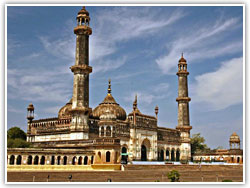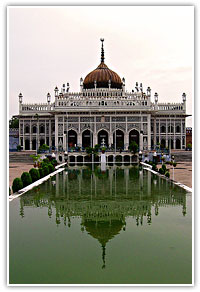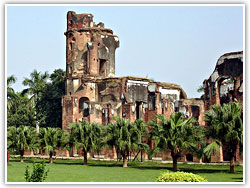|
|
Lucknow Attractions
.............................................................................................................................................................................. |
|
Tourist
Attractions in Lucknow
Bara Imambara, Hussainabad Imambara, Rumi Darwaza,
Lakshman Tila, Picture Gallery, Dilkusha Kothi, Chowk,
The Residency, Dr. Bhim Rao Ambedkar Memorial and State
Museum are the main tourist attractions in Lucknow.
|
| |
|
Bara Imambara
The main attraction of Lucknow is the Bara (Big)
Imambara, also known as Asafi Imambara. It was
built by Nawab Asif-ud-Daula in 1784 and one of
the architectural wonders of Lucknow. It was
constructed to provide employment during a famine.
The absence of beams and pillaris in the huge main
hall is an architectural wonder. Its central hall
is said to be the largest vaulted chamber in the
world. Except for the galleries in the interior,
there is no wood work in the |
 |
|
|
entire
structure. It has a charming accurate labyrinths
supporting the roof of the edifice, known as ‘Bhul-Bhulaiya’.
Here, various visitors are totally lost and so they are
strictly advised to visit only with a guide. One could
wander through narrow zigzag galleries for hours without
finding the way out. Within the compound of the Imambara
is the grand Asafi Masjid.
Rumi Darwaza
The Rumi Darwaza is the massive gateway of the Bara
Imambara. This colossal and ornated gateway is presumed
to be a facsimile of one of the gateways of
Constantinople in Turkey.
Chowk
Chowk is the main bazaar in the old city. Here flourish
the saris, gold and silver brocades, clay figures,
pottery and folk embroidery. It was the haunt of the
feudal aristocracy in the old days and is still the
place for good bargains. Old ‘Nawabi’ houses are also
situated in the area which are still inhabited by
patrician families. It is here that the old culture and
gracious ‘Nawabi’ manners still persist, that reminds of
the 18th century culture of Lucknow. |
|
|
|
Hussainabad
Imambara
Hussainabad Imambara, also known as the Chotta
(small) Imambara houses the tombs of Muhammad Ali
Shah and his mother. This Imambara was built by
Muhammad Ali Shah in a florid Saracenic style with
a dome, turrets and minarets. This Imambara has
numerous domes and minarets. The hall contained a
silver throne and is very picturesque when
illuminated. The 67 meter high clock tower
opposite the Imambara was built between 1860 and
1887.
Dilkusha Kothi
Dilkusha Kothi is set amidst lush green lawns and
was built in the Gothic style. The Kothi and its
adjoining magnificent garden were created by Nawab
Saadat Ali Khan. It is almost an exact replica of
an English country house called Seeaton Delavel,
built in 1721.
|
 |
|
|
Dr.
Bhim Rao Ambedkar Memorial
Dr. Bhim Rao Ambedkar Memorial is the newly added
attraction in Lucknow. This memorial is spread over 53
acres of land in Gomti Nagar, and dedicated in the
memory of Dr. B.R. Ambedkar. In the heart of this
sprawling complex, stands a 112 feet high memorial
resembling a Stupa, with a 16 feet high bronze statue of
Dr. Ambedkar. Numerous figures of life-size elephant,
lush gardens with a 20 feet. wide canal surrounds the
memorial.
Lakshman Tila
Lakshman Tila is situated on the right banks of the
river Gomti and was the original site of Lucknow in the
15th century. This place is now crowned by the mosque of
Aurangzeb. A family from Bijnor also built a fort here
at the end of the 13th century. It then passed through a
number of hands, including the Sharqi kings of Jaunpur
and Sher Shah of Delhi.
State Museum
The State Museum is the oldest museum in Uttar Pradesh
and one of the richest in India. This museum has a
fascinating collection of artifacts from the first to
eleventh centuries, stone sculptures from Mathura, busts
and friezes from Allahabad and Garhwa, Hindu and
Buddhists and Jain works and an Egyptian mummy. The
relics of the British Raj are kept in the backyard of
the museum where you can also see a range of marble
sculptures of the former British citizens, removed at
the time of independence when they were replaced by the
statues deemed to be more appropriate. |
|
|
|
The Residency
The Residency was designed by the Saadat Ali for
the British Resident during 1780-1800. Here many
dramatic events during the first war of
independence in 1857 took place. This building is
now in ruins and still bears the scars of
destruction. The ground floor houses a small
museum in which there is a model that shows the
layout of the whole area in 1857. The gardens
around the Residency are beautifully kept and are
peaceful. Daily light and sound show is held here
which recounts |
 |
|
|
the
history of Awadh through the character of the river,
Gomti. This sound show is held against the romantic
backdrop of the Residency. The skillful use of light and
shade, with an evocative narration, brings alive the
history of Lucknow. The picture gallery is situated
nearby which contains the portraits of Nawabs of Oudh.
Excursion
from Lucknow
Sravasti
Sravasti was an important city at the time of Buddha.
Buddha lived and preached at the monastery of Jetavana
in Sravasti. He also performed some miracles here to
convince the non-believers about the truth of his
religion. After his death, the monastery enjoyed royal
patronage, particularly from Ashoka and it remained
active until the 11th century. The remains of the city
and monastery are around the current villages of Maheth
and Seth which are no more than half a kilometer apart.
Maheth on the banks of the Achiravati river consists of
an earthern embankment and the ruins of two stupas and
temples. Seth contains the remains of the Jetavana
monastery.
Dudhwa National Park
Dudhwa National Park is situated about 238 kms north of
Lucknow. The terrain and vegetation is that of the terai.
With an area of 613 square km and bordering the Sarda
River, Dudhwa has tigers, leopards, sambar, swamp deer
and nilgai. It is famous for its sloth bears. Like
Corbett, it has a rich birdlife. The park is open from
the mid of November to mid of June and the best season
for viewing the large game is March to June.
Faizabad
Faizabad was once the capital of Oudh and was also
called Bungle. The town is situated of the south banks
of the Ghanghara River. Many of the stories in the
Ramayana are supposed to have taken place here. Guptar
Park, for example, is where Rama is believed to have
disappeared. Faizabad was developed as a township nearly
220 years ago, during the reign of Safdar Jung, the
second Nawab of Avadh, who laid its foundation by making
it his army headquarters. Shuja-ud-Daula (1754-75), the
third Nawab of Oudh, settled at Faizabad after 1764 and
built a fort known as Chhota Calcutta, now in ruins,
after his defeat by the British as Buxar in 1764. His
widow Bahu Begum remained in Faizabad while his
successor Asaf-ud-Daula moved to Lucknow. In 1765, he
built the Chowk and Tripaulia and subsequently laid out
the Anguribagh, Motibagh, Asafbagh and Bulandbagh.
During the reign of Siraj-ud-daula, Faizabad attained
prosperity which it never saw again. The glory of
Faizabad eclipsed with the shifting of capital from
Faizabad to Lucknow by Nawab Asaf-ud-daula. The
principal achievement of the period was the mausoleum of
Siraj-ud-daula, known as Gulab Bari. It is a striking
building of fine properties and stands in a garden
surrounded by a wall, approachable through two large
gateways. The Gulab Bari was probably influenced by the
design of Bahu Begum’s. It also contains the tombs of
his mother and father. Siraj-ud-daula’s wife was well
known as Bahu Begum, who married the Nawab in 1743 and
continued to reside in Faizabad. Bahu Begum’s Mausoleum
is ‘the fist mausoleum in UP’ according to Rushbrook
Williams. The tomb is 42 m high and in white marble. The
tomb of Bahu Begum is located at Jawaharbagh. There are
no inscriptions. It is considered to be one of the
finest buildings of its kind in Avadh, which was built
at the cost of three lakh rupees by her chief advisor
Darab Ali Khan. A fine view of the city can be had from
top of the tomb. Most of the Muslim buildings at
Faizabad are attributed to the Bahu Begum. |
|